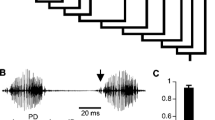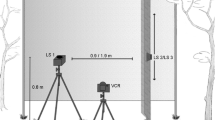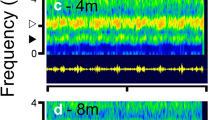Summary
-
1.
Phonotactic approaches (N=156) of 42 female green treefrogs (Hyla cinerea) were videotaped over a distance of 3.75 m in response to synthetic mating calls (0.9 kHz and 0.9, 2.7 and 3.0 kHz).
-
2.
To quantify the accuracy of phonotaxis, jump anglesγ and head orientation angles α were measured (Fig. 2) when the animals were 1 m or farther from the sound source.
-
3.
Phonotaxis was extremely accurate in response to the 3-component call, which is behaviorally equivalent to the male's natural mating call. The mean jump angle was\(\bar \gamma = 16.1^\circ\) (Fig. 5). Head scanning occurred prior to about 25% of the jumps. The accuracy of head orientation after scanning was even greater\((\bar \alpha = 8.4^\circ )\) as were the subsequent jumps\((\bar \gamma = 11.8^\circ )\) (Fig. 6 and Table 1).
-
4.
With respect to the two synthetic calls no statistically significant differences in jump accuracy were found (Table 1). Thus the high frequency components around 3 kHz, normally found in the mating call, do not enhance the accuracy of sound localization.
-
5.
Our results are discussed in terms of models of sound localization in vertebrates and invertebrates, and we suggest that the treefrog's ear must act as a sound pressure gradient receiver.
Similar content being viewed by others
References
Autrum, H.: Über Lautäußerungen und Schallwahrnehmung bei Arthropoden. II. Das Richtungshören vonLocusta und Versuch einer Hörtheorie für Tympanalorgane vom Locustidentyp. Z. Vergl. Physiol.28, 327–352 (1940)
Beranek, L.L.: Acoustics. New York: McGraw-Hill 1954
Chung, S.G., Pettigrew, A., Anson, M.: Dynamics of the amphibian middle ear. Nature London272, 142–147 (1978)
Erulkar, S.D.: Comparative aspects of spatial localization of sound. Physiol. Rev.52, 237–360 (1972)
Feng, A.S., Capranica, R.R.: Sound localization in anurans. I. Evidence of binaural interaction in dorsal medullary nucleus of bullfrogs (Rana catesbeiana). J. Neurophysiol.39, 871–881 (1976)
Feng, A.S., Capranica, R.R.: Sound localization in anurans. II. Binaural interaction in superior olivary nucleus of the green treefrog (Hyla cinerea). J. Neurophysiol.41, 43–54 (1978)
Feng, A.S., Gerhardt, H.C., Capranica, R.R.: Sound localization behavior of the green treefrog (Hyla cinerea) and the barking treefrog (H. gratiosa). J. Comp. Physiol.107, 241–252 (1976)
Gerhardt, H.C.: The significance of some spectral features in mating call recognition in the green treefrog (Hyla cinera). J. Exp. Biol.61, 229–241 (1974)
Griffin, D.R., Dunning, D.C., Cahlander, D.A., Webster, F.A.: Correlated orientation sounds and ear movements of horseshoe bats. Nature196, 1185–1186 (1962)
Hill, K.G., Boyan, G.S.: Sensitivity to frequency and direction of sound in the auditory system of crickets (Gryllidae). J. Comp. Physiol.121, 79–97 (1977)
Klumpp, R.G., Eady, H.R.: Some measurements of interaural time difference thresholds. J. Acoust. Soc. Am.28, 859–860 (1956)
Knudsen, E., Konishi, M.: Personal communication (in preparation) (1979)
Konishi, M.: Locatable and non-locatable acoustic signals for barn owls. Am. Nat.107, 775–785 (1973)
Larsen, O.N., Michelsen, A.: Biophysics of the ensiferan ear. III. The cricket ear as a four-input system. J. Comp. Physiol.123, 217–227 (1978)
Lewis, D.B.: The physiology of the tettigoniid ear. II. The response characteristics of the ear to differential inputs: Lesion and blocking experiments. J. Exp. Biol.60, 839–851 (1974)
Michelsen, A., Nocke, H.: Biophysical aspects of sound communication in insects. Adv. Insect Physiol.10, 247–296 (1974)
Mills, A.W.: Auditory localization. In: Foundations of modern auditory theory, Vol. II. Tobias, J.V. (ed.), pp. 303–348. New York: Academic Press 1972
Moushegian, G., Stillman, R.D., Rupert, A.L.: Characteristic delays in superior olive and inferior colliculus. In: Physiology of the auditory system. Sachs, M.B. (ed.), pp. 245–254. Baltimore, Maryland: National Educational Consultants 1970
Murphey, R.K., Zaretsky, M.D.: Orientation to calling song by female crickets,Scapsipedus marginatus (Gryllidae). J. Exp. Biol.56, 335–352 (1972)
Neff, W.D.: Localization and lateralization of sound in space. In: Ciba Foundation Hearing Mechanisms in Vertebrates. Reuck, A.V.S. de, Knight, J. (eds.), pp. 207–233. London: Churchill 1968
Oldham, R.S., Gerhardt, H.C.: Behavioral isolating mechanisms of the treefrogsHyla cinerea andH. gratiosa. Copeia2, 223–230 (1975)
Olson, H.F.: Gradient microphones. J. Acoust. Soc. Am.17, 192–193 (1943)
Payne, R.S.: Acoustic location of prey by barn owls (Tyto alba). J. Exp. Biol.56, 535–573 (1971)
Pumphrey, R.J.: Hearing in insects. Biol. Rev.15, 107–132 (1940)
Pye, J.D., Flinn, M., Pye, A.: Correlated orientation sounds and ear movements of horseshoe bats. Nature196, 1186–1188 (1962)
Pye, J.D., Roberts, L.H.: Ear movements in a Hipposiderid bat. Nature225, 285–286 (1970)
Schwartzkopff, J.: Beitrag zum Problem des Richtungshörens bei Vögeln. Z. Vergl. Physiol.32, 319–327 (1950)
Shaw, E.A.G.: The external ear. In: Handbook of sensory physiology V/1. Keidel, W.D., Neff, W.D.S. (eds.), pp. 455–490.Berlin, Heidelberg, New York: Springer 1974
Simmons, J.A., Vernon, J.A.: Echolocation: discrimination of targets by the batEptesicus fuscus. J. Exp. Zool.176, 315–328 (1971)
Strother, W.F.J.: The electrical response of the auditory mechanisms in the bullfrog (Rana catesbeiana). J. Comp. Physiol. Psychol.52, 157–162 (1959)
Webster, F.A.: Active energy radiating systems: the bat and ultrasonic principles. II. Acoustical control of airborne interceptions by bats. In: Proc. Intern. Congress Technol. Blind 1963
Zwislocki, J., Feldman, R.S.: Just noticeable differences in dichotic phase. J. Acoust. Soc. Am.28, 860–864 (1956)
Author information
Authors and Affiliations
Additional information
(BNS-7300795; NS-00217-02) and to R.R. Capranica (NS-09244). We especially appreciate the cooperation of the staff of the Savannah Science Museum for letting us use their facilities. We thank Richard Daniel, Steve A. Perrill and Sarah Hopkins for assistance and Mary Vella for typing the manuscript. A.J.M. Moffat and R.B. Coles critically read the manuscript and contributed excellent comments.
Rights and permissions
About this article
Cite this article
Rheinlaender, J., Gerhardt, H.C., Yager, D.D. et al. Accuracy of phonotaxis by the green treefrog (Hyla cinerea). J. Comp. Physiol. 133, 247–255 (1979). https://doi.org/10.1007/BF00661127
Accepted:
Issue Date:
DOI: https://doi.org/10.1007/BF00661127




